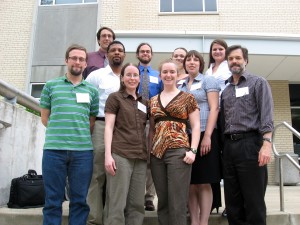
Standing in the front row, from left, is Philip Janini; Erika Gibb, assistant professor of physics and astronomy at UMSL; Lauren Stephenson; Emily Sudholt; and Bruce Wilking, chair of the Department of Physics and Astronomy at UMSL. Standing in the back row is David Peaslee; Robert Dobynes; David Coss; Rosaura Salinas; and Ellie Ordway. Not pictured is Kristen Erickson.
Nine students from the University of Missouri–St. Louis participated in the 19th annual NASA/Missouri Space Grant Consortium April 23 and 24 at Missouri State University in Springfield, Mo. Students worked with advisers from the Department of Physics and Astronomy and the Center for Nanoscience at UMSL to complete the projects they presented to more than 100 research students and advisers from across the state. The consortium includes all four University of Missouri campuses, Washington University in St. Louis, Missouri State University in Springfield and Lincoln University in Jefferson City, Mo.
Bruce Wilking, professor and chair in the Department of Physics and Astronomy at UMSL, said, “In the past 10 years, we have supported more than 50 students in various projects. The Space Grant Consortium has contributed to public outreach programs with the campus’ planetarium and the Richard D. Schwartz Observatory.”
The planetarium program at UMSL, which began in 1992, has brought more than 7,000 fifth grade students and teachers to campus to learn about the motions of the sun, moon and planets in the St. Louis sky.
In astrophysics, physics major Lauren Stephenson of Overland, Mo., discussed her analysis of photometry and spectroscopy of young stars in the Ophiuchus molecular cloud to identify young stellar objects and derive their ages and masses.
Doctoral physics student Kristen Erickson of Maryland Heights, Mo., presented a poster based on Stephenson’s results, and using a much larger sample, an investigation that will provide insight into how a cloud fragments to form stars. Chemistry major Philip Janini of Affton, Mo., and chemistry major Emily Sudholt of Columbia, Mo., discussed their analysis of heavy water in the spectra of two comets to see if such comets could have produced the Earth’s oceans. Doctoral physics student David Coss of St. Louis, Mo., discussed his computer simulations of gravitational lensing by dark matter haloes of galaxy clusters.
In materials science, physics major Ellie Ordway of Jefferson City, Mo., discussed the results from her summer internship with MEMC Electronic Materials Inc. in St. Peters, Mo., including the analysis of strain on silicon-on-insulator wafers due to implantation of hydrogen and helium studied using X-ray diffraction. Physics major Rosaura Salinas of O’Fallon, Mo., presented a poster on the synthesis of iron oxide nanowires coated with zinc oxide that may have applications in solar cells. Doctoral physics student David Peaslee of St. Louis, presented a poster on the experimental results of using metal hydrides to store hydrogen for fuel cells.
Emily Sudholt, Rosaura Salinas and Robert Dobynes, a physics major from O’Fallon, Mo., described the UMSL Planetarium Program to the group.
The NASA/Missouri Space Grant Consortium just completed its 20th year review, and its proposal for continued funding by NASA has been approved. The mission of the Missouri Consortium of the National Space Grant College and Fellowship Program is to maintain and enhance, through the state’s research universities and corporate partners, the nation’s work force capabilities in aerospace and space related science, engineering and technology; and to aid in the dissemination of NASA-related information to students, faculty, researchers and the general public. The specific goals of the consortium are to inspire, motivate, recruit, educate and train students at all academic levels to help meet Missouri’s and NASA’s need for skilled, knowledgeable, diverse, and high-performing professional scientists, engineers, technologists and educators in the fields of interest to NASA.
More information:
http://tinyurl.com/2cfy459














